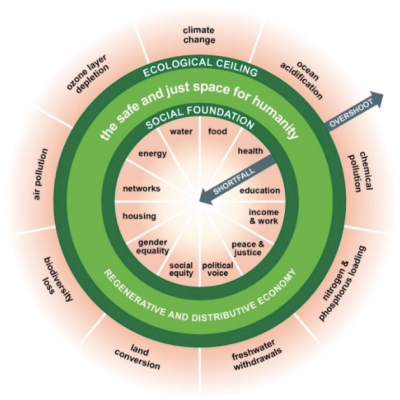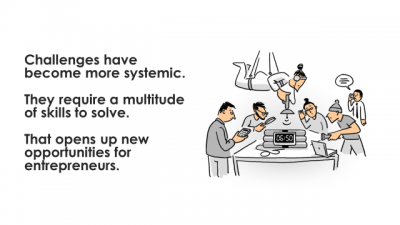In the third lecture in the Global Entrepreneurship Speaker Series (GESS) sponsored by UConn Global Business Programs and the Werth Institute, special guest, Peter Barkman challenged our views of economic growth as an entrée to talking about innovation and disruption.
Barkman, currently SVP, and minority owner of SOLITA a technology and service design consultancy is also a serial entrepreneur, angel investor, part-owner of 5 companies and thought leader in entrepreneurship both in Finland and globally, took a foundational approach as he drew students into his presentation, explaining the evolution of economic theory, stating that some of its core assumptions are faulty.
Humans are not always rational, growth is not eternal and the markets are neither perfect in action or knowledge. Thus, the idea that economics is a science has created a trap for business and business leaders.
He asked the student audience questions such as: Is the exponential growth of the last 40 years possible forever? Or how long can we count on it? What happens when it is no longer viable? Are Data or IT the saviors? Barkman stated that “we are looking at the single biggest re-think of societies and ways of organizing human activity ever – bigger that the industrial or info-tech revolutions – and it is happening fast.”
Barkman quoted Peter Drucker, who in the early 90’s, before ever even seeing a browser, saw that technology would change the world in fundamental ways by serving as the vehicle which would change knowledge from a resource to the resource.
Transitioning onto a more concrete path, Barkman named the driving factors of growth, for and by humans, as energy, technology and nature. “We use energy to refine natural resources and enable this refinement with technology. If we learn to harness energy and minimize and learn to utilize natural resources in a totally different way, who can then say growth is not infinite?”

The problem, Barkman says, is that our way of analyzing and interpreting what is going on in the world is out-dated and if we do not change that model – and thus our thinking – we are doomed.
He offered an alternative model, introducing students to the Donut model developed by British economist Kate Raworth. Raworth argues that “the aim of economic activity should be “meeting the needs of all within the means of the planet”.
“The diagram consists of two rings. The inner ring of the doughnut represents a sufficiency of the resources we need to lead a good life. Anyone living within that ring, in the hole in the middle of the doughnut, is in a state of deprivation. The outer ring of the doughnut consists of the Earth’s environmental limits, beyond which we inflict dangerous levels of climate change, ozone depletion, water pollution, loss of species and other assaults on the living world. The area between the two rings – the doughnut itself – is the “ecologically safe and socially just space” in which humanity should strive to live. The purpose of economics should be to help us enter that space and stay there. Billions of people still live in the hole in the middle. We have breached the outer boundary in several places” (The Guardian, 12 Apr 2017).
From explaining this new model for thinking about economic growth in society, Barkman moved onto its implication in two industries he consults in – energy and transportation. “Energy is abundant and eternal”, he said. “It never disappears, it just changes form” and we need to learn how best to utilize it. Touching on the future of mobility, he shared that car dealers themselves have predicted that “car sales in its current format will disappear by the year 2024.”

Barkman finally encouraged students to get a grasp of design thinking. The problems in different industries overlap at many levels. They require the best minds from a variety of backgrounds to provide solutions. Barkman challenged students to incorporate as many different types of expertise and knowledge into the teams for their entrepreneurial endeavors. He shared that when he first entered the corporate world, he had a great job, but everyone in the company had a similar educational background, expertise and mode of thinking. What he has found in recent years is that diversity in knowledge is much more conducive to thinking innovatively about a given problem or task. Differing approaches foster an energy and chemistry that promotes creativity. One team member might say – “That’s not possible!” The answer, Peter Barkman says is, of course “I thought it; I said it. It is not impossible!”
As an example, Barkman referred to two startups who are attacking the sustainability challenge companies face. The two approaches are different, but they work in concert to help companies, or any actors, make the world a better place. The Upright Project aims to create an automated way of quantifying net impact of companies on people, planet, society and knowledge. GoodPurpose is creating a platform to measure the impact of every good act done by any one, any company, any city and make it available in one place to provide knowledge for even more responsible choices…by everyone.
After providing these inspirational examples – Barkman asked his final questions to students – Where will you make a splash? What will you disrupt?

Arminda Kamphausen
UConn School of Business
Associate Director, Global Business Programs, CIBER, GE Global Learning Center